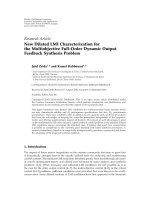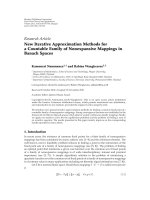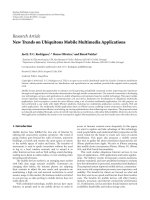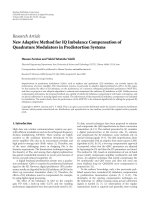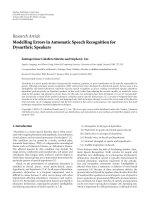Báo cáo hóa học: " Research Article New Strengthened Carleman’s Inequality and Hardy’s Inequality" docx
Bạn đang xem bản rút gọn của tài liệu. Xem và tải ngay bản đầy đủ của tài liệu tại đây (466.21 KB, 7 trang )
Hindawi Publishing Corporation
Journal of Inequalities and Applications
Volume 2007, Article ID 84104, 7 pages
doi:10.1155/2007/84104
Research Article
New Strengthened Carleman’s Inequality and Hardy’s Inequality
Haiping Liu and Ling Zhu
Received 26 July 2007; Accepted 9 November 2007
Recommended by Ram N. Mohapatra
In this note, new upper bounds for Carleman’s inequality and Hardy’s inequality are es-
tablished.
Copyright © 2007 H. Liu and L. Zhu. This is an open access article distributed under the
Creative Commons Attribution License, which permits unrestricted use, distribution,
and reproduction in any medium, provided the original work is properly cited.
1. Introduction
The following Carleman’s inequality and Hardy’s inequality are well known.
Theorem 1.1 (see [1, Theorem 334]). Let a
n
≥ 0(n ∈ N) and 0 <
∞
n=1
a
n
< + ∞, then
∞
n=1
a
1
a
2
···a
n
1/n
<e
∞
n=1
a
n
. (1.1)
Theorem 1.2 (see [1, Theorem 349]). Let 0 <λ
n+1
≤ λ
n
, Λ
n
=
n
m
=1
λ
m
, a
n
≥ 0(n ∈ N)
and 0 <
∞
n=1
λ
n
a
n
< +∞, then
∞
n=1
λ
n+1
a
λ
1
1
a
λ
2
2
···a
λ
n
n
1/Λ
n
<e
∞
n=1
λ
n
a
n
. (1.2)
In [2–16], some refined work on Carleman’s inequality and Hardy’s inequalit y had
been gained. It is observ ing that in [3] the authors obtained the following inequalities
1+
1
n
n
1+
1
n +1/5
1/2
<e<
1+
1
n
n
1+
1
n +1/6
1/2
. (1.3)
2 Journal of Inequalities and Applications
From the inequality above, [3, 4] extended Theorems A and B to the following new re-
sults.
Theorem 1.3 (see [3, Theorem 1]). Let a
n
≥ 0(n ∈ N) and 0 <
∞
n=1
a
n
< +∞, then
∞
n=1
a
1
a
2
···a
n
1/n
<e
∞
n=1
1+
1
n +1/5
−1/2
a
n
. (1.4)
Theorem 1.4 (see [4, Theorem]). Let 0 <λ
n+1
≤ λ
n
, Λ
n
=
n
m
=1
λ
n
, a
n
≥ 0(n ∈ N) and
0 <
∞
n=1
λ
n
a
n
< +∞, then
∞
n=1
λ
n+1
a
λ
1
1
a
λ
2
2
···a
λ
n
n
1/Λ
n
<e
∞
n=1
λ
n
1+
1
Λ
n
/λ
n
+1/5
−1/2
a
n
. (1.5)
In this note, Carleman’s inequality and Hardy’s inequality are strengthened as follows.
Theorem 1.5. Let a
n
≥ 0(n ∈ N), 0 <
∞
n=1
a
n
< +∞,andc ≥
√
6/4. Then
∞
n=1
a
1
a
2
···a
n
1/n
<e
∞
n=1
1 −
λ
n
2cn +4c/3+1/2
c
a
n
. (1.6)
Theorem 1.6. Let c
≥
√
6/4, 0 <λ
n+1
≤ λ
n
, Λ
n
=
n
m
=1
λ
m
, a
n
≥ 0(n ∈ N),and
0 <
∞
n=1
λ
n
a
n
< +∞. Then
∞
n=1
λ
n+1
a
λ
1
1
a
λ
2
2
···a
λ
n
n
1/Λ
n
<e
∞
n=1
1 −
λ
n
2cΛ
n
+(4c/3+1/2)λ
n
c
λ
n
a
n
. (1.7)
In order to prove two theorems mentioned above, we need introduce several lemmas
first.
2. Lemmas
Lemma 2.1. Let x>0 and c
≥
√
6/4.Theninequality
1+
1
x
x
1+
1
2cx +4c/3 −1/2
c
<e (2.1)
or
1+
1
x
x
<e
1 −
1
2cx +4c/3+1/2
c
(2.2)
holds. Furthermore, 4c/3
− 1/2 is the best constant in inequality (2.1)or4c/3+1/2 is the
best constant in inequalit y (2.2).
Proof. (i) We construct a function as
f (x)
= x ln
1+
1
x
+ c ln
1+
1
2cx + b
−
1, (2.3)
H. Liu and L. Zhu 3
where x
∈ (0,+∞)andb = 4c/3 −1/2. It is obvious that the existence of Lemma 2.1 can
be ensured when proving f (x) < 0. We simply compute
f
(x) = ln
1+
1
x
−
1
x +1
+2c
2
1
2cx + b +1
−
1
2cx + b
,
f
(x) =−
1
x(x +1)
+
1
(x +1)
2
+4c
3
1
(2cx + b)
2
−
1
(2cx + b +1)
2
=−
1
x(x +1)
2
+
4c
3
(4cx +2b +1)
(2cx + b)
2
(2cx + b +1)
2
=−
p(x)
x(x +1)
2
(2cx + b)
2
(2cx + b +1)
2
,
(2.4)
where p(x)
= (24b
2
c
2
+24bc
2
+4c
2
−16c
4
−16bc
3
−8c
3
)x
2
+(8b
3
c +4b
2
c +4bc −8bc
3
−
4c
3
)x + b
2
(b +1)
2
.Sincex ∈ (0,+∞), b = 4c/3 −1/2, and c ≥
√
6/4, we have
24b
2
c
2
+24bc
2
+4c
2
−16c
4
−16bc
3
−8c
3
≥ 0,
8b
3
c +4b
2
c +4bc−8bc
3
−4c
3
> 0,
b
2
(b +1)
2
> 0.
(2.5)
From the above analysis, we easily get that f
(x) < 0and f
(x)isdecreasingon(0,+∞).
Meanwhile f
(x) > lim
x→+∞
f
(x) = 0forx ∈ (0,+∞). Thus, f (x)isincreasingon(0,+∞),
and f (x) < lim
x→+∞
f (x) = 0forx ∈ (0,+∞).
(ii) The inequality (2.2)isequivalentto
e
1/c
e
1/c
−(1 + 1/x)
x/c
−2cx <
4
3
c +
1
2
, x>0. (2.6)
Let g(t)
= (1 + t)
1/(ct)
and t>0. Then
g
0
+
=
lim
t→0
+
(1 + t)
1/(ct)
c
1
t(1 + t)
−
log(1 + t)
t
2
=−
e
1/c
2c
,
g
0
+
=
lim
t→0
+
(1 + t)
1/(ct)
c
2
1
t(1 + t)
−
log(1 + t)
t
2
2
+lim
t→0
+
(1 + t)
1/(ct)
−
3t
2
−2t +2
1+t
2
log(1 + t)
ct
3
(1 + t)
2
=
1
4c
2
+
2
3c
e
1/c
.
(2.7)
Using Taylor’s formula, we have
g(t)
= e
1/c
−
e
1/c
2c
t +
1
2
1
4c
2
+
2
3c
e
1/c
t
2
+ o
t
2
. (2.8)
4 Journal of Inequalities and Applications
When letting x
= 1/t and using (2.8) we find that
lim
x→+∞
e
1/c
e
1/c
−(1 + 1/x)
x/c
−2cx
=
lim
t→0
+
te
1/c
−2c
e
1/c
−(1 + t)
1/(ct)
t
e
1/c
−(1 + t)
1/(ct)
=
lim
t→0
+
1/(4c)+2/3
e
1/c
t
2
+ o
t
2
e
1/c
t
2
/(2c)+o
t
2
=
4
3
c +
1
2
.
(2.9)
Therefore, 4c/3+1/2 is the best constant in (2.2).
Lemma 2.2. The inequality
1+
1
n +1/5
1/2
<
1+
2
3n +1
3/4
(2.10)
holds for every positive integer n.
Proof. Let
h(x)
=
1
2
ln
1+
1
x +1/5
−
3
4
ln
1+
2
3x +1
(2.11)
for x
∈ [1,+∞), then
h
(x) =
x/5 −7/25
2(x +6/5)(x +1/5)(x + 1)(3x +1)
. (2.12)
Thus, h(x)isdecreasingon[1,7/5). Since for h(1) < 0, we have h(x) < 0on[1,7/5). At
the same time, h(x) is increasing on [7/5,+
∞), and we have h( x) < lim
x→+∞
h(x) = 0on
[7/5,+
∞). Hence h(x) < 0on[1,+∞). By the definition of h(x), it turns out that the
inequality (2.10)isaccrate.
In the same way we can prove the following result.
Lemma 2.3. The inequality
1+
2
3n +1
3/4
<
1+
1
(5/4)n +1/3
5/8
(2.13)
holds for every positive integer n.
Combining Lemmas 2.1, 2.2,and2.3 gives
Lemma 2.4. The inequality
1+
1
n
n
1+
1
n +1/5
1/2
<
1+
1
n
n
1+
2
3n +1
3/4
<
1+
1
n
n
1+
1
(5/4)n +1/3
5/8
<e
(2.14)
holds for every positive integer n.
H. Liu and L. Zhu 5
3. Proof of Theorem 1.5
By the virtue of the proof of article [3], we can testify Theorem 1.5. Assume that c
n
> 0
for n
∈ N. Then applying the arithmetic-geometric average inequality, we have
∞
n=1
a
1
a
2
···a
n
1/n
=
∞
n=1
c
1
c
2
···c
n
−1/n
c
1
a
1
c
2
a
2
···c
n
a
n
1/n
≤
∞
n=1
c
1
c
2
···c
n
−1/n
1
n
n
m=1
c
m
a
m
=
∞
m=1
c
m
a
m
∞
n=m
1
n
c
1
c
2
···c
n
−1/n
.
(3.1)
Setting c
m
= (m +1)
m
/m
m−1
,wehavec
1
c
2
···c
n
= (n +1)
n
and
∞
n=1
a
1
a
2
···a
n
1/n
≤
∞
m=1
c
m
a
m
∞
n=m
1
n(n +1)
=
∞
m=1
1
m
c
m
a
m
=
∞
m=1
1+
1
m
m
a
m
.
(3.2)
By (3.2)and(2.2), we obtain
∞
n=1
a
1
a
2
···a
n
1/n
<e
∞
n=1
1 −
1
2cn +4c/3+1/2
c
a
n
. (3.3)
Thus, Theorem 1.5 is proved.
4. Proof of Theorem 1.6
Now, processing the proof of Theorem 1.6. Assume that c
n
> 0forn ∈ N. Using the
arithmetic-geometric average inequality we obtain
∞
n=1
λ
n+1
a
λ
1
1
a
λ
2
2
···a
λn
n
1/Λ
n
=
∞
n=1
λ
n+1
c
λ
1
1
c
λ
2
2
···c
λ
n
n
1/Λ
n
c
1
a
1
λ
1
c
2
a
2
λ
2
···
c
n
a
n
λ
n
1/Λ
n
≤
∞
n=1
λ
n+1
c
λ
1
1
c
λ
2
2
···c
λ
n
n
1/Λ
n
1
Λ
n
n
m=1
λ
m
c
m
a
m
=
∞
m=1
λ
m
c
m
a
m
∞
n=m
λ
n+1
Λ
n
c
λ
1
1
c
λ
2
2
···c
λ
n
n
1/Λ
n
.
(4.1)
6 Journal of Inequalities and Applications
Choosing c
n
= (1 + λ
n+1
/Λ
n
)
Λ
n
/λ
n
Λ
n
,wegetthat
∞
n=1
λ
n+1
a
λ
1
1
a
λ
2
2
···a
λn
n
1/Λ
n
≤
∞
m=1
1+
λ
m+1
Λ
m
Λ
m
/λ
m
λ
m
a
m
≤
∞
m=1
1+
1
Λ
m
/λ
m
Λ
m
/λ
m
λ
m
a
m
<e
∞
m=1
1 −
1
2c
Λ
m
/λ
m
+4c/3+1/2
c
λ
m
a
m
= e
∞
m=1
1 −
λ
m
2cΛ
m
+(4c/3+1/2)λ
m
c
λ
m
a
m
,
(4.2)
from (4.1)and(2.2).
References
[1] G. H. Hardy, J. E. Littlewood, and G. P
´
olya, Inequalities, Cambridge University Press, Cam-
bridge, UK, 1952.
[2] B C. Yang, “On Hardy’s inequality,” Journal of Mathematical Analysis and Applications, vol. 234,
no. 2, pp. 717–722, 1999.
[3] P. Yan and G Z. Sun, “A strengthened Carleman’s inequality,” Journal of Mathematical Analysis
and Applications, vol. 240, no. 1, pp. 290–293, 1999.
[4] J L. Li, “Notes on an inequality involving the constant e,” Journal of Mathematical Analysis and
Applications, vol. 250, no. 2, pp. 722–725, 2000.
[5] B C. Yang and L. Debnath, “Some inequalities involving the constant e , and an application to
Carleman’s inequality,” Journal of Mathematical Analysis and Applications, vol. 223, no. 1, pp.
347–353, 1998.
[6] Z T. Xie and Y B. Zhong, “A best approximation for constant e and an improvement to Hardy’s
inequality,” Journal of Mathematical Analysis and Applications, vol. 252, no. 2, pp. 994–998, 2000.
[7] X J. Yang, “On Carleman’s inequality,” Journal of Mathematical Analysis and Applications,
vol. 253, no. 2, pp. 691–694, 2001.
[8] X J. Yang, “Approximations for constant e and their applications,” Journal of Mathematical
Analysis and Applications, vol. 262, no. 2, pp. 651–659, 2001.
[9] M. Gyllenberg and P. Yan, “On a conjecture by Yang,” Journal of Mathematical Analysis and
Applications, vol. 264, no. 2, pp. 687–690, 2001.
[10] B Q. Yuan, “Refinements of Carleman’s inequality,” Journal of Inequalities in Pure and Applied
Mathematics, vol. 2, no. 2, article 21, pp. 1–4, 2001.
[11] S. Kaijser, L E. Persson, and A.
¨
Oberg, “On Carleman and Knopp’s inequalities,” Journal of
Approximation Theory, vol. 117, no. 1, pp. 140–151, 2002.
[12] M. Johansson, L E. Persson, and A. Wedestig, “Carleman’s inequality-history, proofs and some
new generalizations,” Journal of Inequalities in Pure and Applied Mathematics, vol. 4, no. 3, article
53, pp. 1–19, 2003.
[13] A.
ˇ
Ci
ˇ
zme
ˇ
sija, J. Pe
ˇ
cari
´
c, and L E. Persson, “On strengthened weighted Carleman’s inequality,”
Bulletin of the Australian Mathematical Society, vol. 68, no. 3, pp. 481–490, 2003.
[14] H W. Chen, “On an infinite series for (1 + 1/x)
x
and its application,” International Journal of
Mathematics and Mathematical Sciences, vol. 29, no. 11, pp. 675–680, 2002.
H. Liu and L. Zhu 7
[15] C P. Chen, W S. Cheung, and F. Qi, “Note on weighted Carleman-type inequality,” Interna-
tional Journal of Mathematics and Mathematical Sciences, vol. 2005, no. 3, pp. 475–481, 2005.
[16] C P. Chen and F. Qi, “On further sharpening of Carleman’s inequality,” College Mathematics,
vol. 21, no. 2, pp. 88–90, 2005 (Chinese).
Haiping Liu: Department of Mathematics, Zhejiang Gongshang University,
Hangzhou 310018, China
Email address:
Ling Zhu: Department of Mathematics, Zhejiang Gongshang University, Hangzhou 310018, China
Email address:


